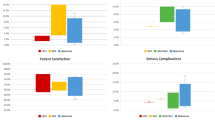Abstract
Increasingly, uterine preservation surgeries are being performed for treating apical prolapse. Several types of procedures and surgical approaches to correct apical prolapse have been described in the literature. Despite this, there remains inadequate information to provide evidence-based recommendations regarding the optimal treatment approach and materials to use, and trials are ongoing to identify the optimal techniques. In the future, our patients may be the strongest determining influence when it comes to choice of apical prolapse surgery, with factors such as autonomy, reproduction, intimacy and fear influencing their decision. It is our opinion that the two most powerful forces behind the choice of apical POP surgical technique are the woman’s personal desire for uterine preservation or not and the surgeon’s personal choice of procedure based on training received. Present management of apical prolapse involves understanding patient goals and acknowledging their treatment preferences and values.
Similar content being viewed by others
References
Jackson SR, Avery NC, Tariton JF, Eckford SD, Abrans P, Bailey AJ. Changes in metabolism of collagen in genitourinary prolapse. Lancet. 1996;347:1658–61.
Blandon RE, Bharucha AE, Melton LJ, et al. Incidence of pelvic floor repair after hysterectomy: a population-based cohort study. Am J Obstet Gynecol. 2007;197(6):664. e1-664.e7
Frick AC, Barber MD, Paraiso MF, Ridgeway B, Jelovsek JE, Walters MD. Attitudes toward hysterectomy in women undergoing evaluation for uterovaginal prolapse. Female Pelvic Med Reconstr Surg. 2013;19(2):103–9.
FitzGerald MP, Elliott C, Brubaker L. New vs. old: descriptors can affect patients’ surgical preferences. Am J Obstet Gynecol. 2008;199(5):476e. 1–476e.3
Korbly NB, et al. Patient preferences for uterine preservation and hysterectomy in women with pelvic organ prolapse. Am J Obstet Gynecol. 2013;209(5):470. e1-6
Marván ML, Quiros V, López-Vázquez E, Ehrenzweig Y. Mexican beliefs and attitudes toward hysterectomy and gender-role ideology in marriage. Health Care Women Int. 2012;33(6):511–24.
Strohbehn K, Jarkary J, DeLancy J. Pelvic organ prolapse in yound women. Obstetr Gyncecol. 1997;90:33–6.
Pandeva I, Mistry M, Fayyad A. Efficacy and pregnancy outcomes of laparoscopic single sheet mesh sacrohysteropexy. Neurourol Urodyn. 2017;36(3):787–93.
Chaudhuri S. The place of sling operations in treating genital prolapse in young women. Int J Gynecol. 1979;16:314–20.
Komisaruk BR, Frangos E, Whipple B. Hysterectomy improves sexual response? Addressing a crucial omission in the literature. J Minim Invasive Gynecol. 2011;18(3):288–95.
Roovers JP, van der Bom JG, van der Vaart CH, Heintz AP. Hysterectomy and sexual wellbeing: prospective observational study of vaginal hysterectomy, subtotal hysterectomy, and abdominal hysterectomy. BMJ. 2003;327:774–8.
Constantini E, Porena M, Lazzeri M, Mearini L, Bini V, Zucchi A. Changes in female sexual function after pelvic organ prolapse repair: role of hysterectomy. Int Urogynecol J. 2013;24(9):1481–7.
Jeng CJ, Yang YC, Tzeng CR, Shen J, Wang LR. Sexual functioning after vaginal hysterectomy or transvaginal sacrospinous uterine suspension for uterine prolapse: a comparison. J Reprod Med. 2005;50(9):669.
Nesbitt R. Uterine preservation in the surgical management of genuine stress urinary incontinence associated with uterovaginal prolapse. Surg Gynecol Obstet. 1989;168(2):143.
O’Brien S, Dua A, Vij M. Practices in pelvic organ prolapse operations among surgeons: an international survey identifying needs for further research. Int Urogynecol J. 2016;27:1221–6.
Kurt S, Canda MT, Tasyurt A. A new surgical method of suprapubic and extraperitoneal approach with uterine preservation for pelvic organ prolapse: kurt extraperitoneal ligamentopexy. ISRN Obstet Gynecol. 2013;17:748232.
Cutner A, Kearney R, Vashisht A. Laparoscopic uterine sling suspension: a new technique of uterine suspension in women desiring surgical management of uterine prolapse with uterine conservation. BJOG. 2007;114(9):1159–62.
Coskun B, Lavelle RS, Alhalabi F, Christie AL, Zimmern PE. Anterior vaginal wall suspension procedure for moderate bladder and uterine prolapse as a method of uterine preservation. J Urol. 2014;192(5):1461–7.
Maher C, Feiner B, Baessler K, Christmann-Schmid C, Haya N, Brown J. Surgery for women with anterior compartment prolapse. Cochrane Database Syst Rev. 2016;11:CD004014.
Dietz V, Schraffordt Koops SE, van der Vaart CH. Vaginal surgery for uterine descent; which options do we have? A review of the literature. Int Urogynecol J Pelvic Floor Dysfunct. 2009;20(3):349–56.
Gutman RE, Rardin CR, Sokol ER, Matthews C, Park AJ, Iglesia CB, et al. Am J Obstet Gynecol. 2017;216(1):38. e1-38.e11
Meriwether KV, Antosh DD, Olivera CK, Kim-Fine S, Balk EM, Murphy M, et al. Uterine preservation vs hysterectomy in pelvic organ prolapse surgery: a systematic review with meta-analysis and clinical practice guidelines. Am J Obstet Gynecol. 2018.
Author information
Authors and Affiliations
Corresponding author
Ethics declarations
Conflicts of interest
BC Anglim has received honorarium for speaking at medical conferences.
OE O’Sullivan has received honorarium to attend medical conferences.
BA O’Reilly has received honorarium to attend medical conferences.
Rights and permissions
About this article
Cite this article
Anglim, B., O’Sullivan, O. & O’Reilly, B. How do patients and surgeons decide on uterine preservation or hysterectomy in apical prolapse?. Int Urogynecol J 29, 1075–1079 (2018). https://doi.org/10.1007/s00192-018-3685-4
Received:
Accepted:
Published:
Issue Date:
DOI: https://doi.org/10.1007/s00192-018-3685-4




